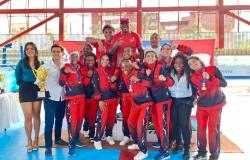First there was concern and then the desire to lend a hand to the residents of the Holy Trinity Home, from La Calera, in Córdoba, which led a group of young university students to lead a solidarity project to reform the municipal nursing home where the city’s elderly live: some have their families who visit them, but others are alone. For this reason, they decided to convert the residence where they live into a more beautiful and comfortable space.
Thus, the old house became the first to be renovated with the desire that it mark a stage of solidarity that can collaborate with the different needs of the area. In search of collaborations, the group spread the proposal to try to get donations. “The objective is to respond to a social need that, in this case, shows that our elderly deserve more attention than they sometimes receive,” he said before the start of the works. Maximus Marcianteone of the young people in charge of Renewal and Hopetoemerged to carry out the structural remodeling of that home for seniors.
It didn’t take long for them to see it done. With absolute personal satisfaction and excited to know that what was done today means that the seven residents have better living conditions, the 23-year-old says: “We left very happy, excited. This made us think a lot because the place was missing many things for them to live a quality life and in a more comfortable place. When we arrived, the first day, we thought a lot about what our life would be like at that age and how, or what would happen if our grandparents were in that situation.”
The project was carried out by the group of young people, between 18 and 23 years old – who belong to the Fraternity of Saint Thomas Aquinas Groups (FASTA), a movement of the Catholic Church that has an educational network in Argentina—and residents of La Calera included four stages (planning, two execution stages, and celebration for the completed work).
José Michelotti, mayor of La Calera between 1932 and 1933, accepted during his administration the donation of some unoccupied houses in the La Isla neighborhood, which were intended to house older adults who were alone or whose families could not care for them.
Thus, in 1935 the municipality of La Calera managed to install the home at the entrance to the neighborhood and the original idea was maintained: to offer them a quiet space in which they could enjoy the sun and a green tree-lined garden. Although the original structure was always maintained, the advancement of the neighborhood and the passing of the years meant that the residents could not enjoy that natural light and the large garden.
As it is the only municipal asylum, the group of about 30 FASTA volunteers did what was necessary to renovate it. At the beginning of each year during a camp in different places in Argentina, young people form an axis. And during 2023, theirs was the common good.

“So, The proposal was to do an apostolic action, which is a short or medium-term project, in which we can do something that achieves a change,” he recalls. They had to do it with an NGO or a political party, and we saw the possibility of approaching the mayor, Fernando Rambaldi, since they chose to start their actions in a smaller city and not in the provincial capital.
Together with other volunteers from the NGO Solidarity Hearts, they took care of cleaning the garden, the kitchen, the bathrooms, the common spaces, and the restoration of the furniture of the home where seven grandparents reside. At the end of the work, the municipality collaborated, which was in charge of cleaning, weeding, painting the building and the necessary work after the group finished its task, such as repairing bathrooms, checking electrical installation, among other things.
“During a youth camp that traveled to Luján, province of Buenos Aires, the proposal was presented and we were awarded the Apostolic Action badge because even before starting it, it already had great dissemination and social and social impact,” he says. He highlights that the help of Corazones Solidarios de La Calera helped them “during this entire process and execution of the apostolic action.”

“I highlight the work of Santiago Morelli, who was one of those in charge of the proposal that began as a project in July of last year and that had its four stages in December. But it was not only something structural but there were also activities for the grandparents: dance days, workshops and many social proposals to motivate them and also bring them joy. When we finished everything, we had a joint celebrationin which the mayor participated, to celebrate the result and the months of work,” he highlights.
At the stage of painting the entire interior, the residents left the home to spend a few very different days. “They lent us cabins in La Calera and they went there to spend the days that it took to paint all the interior walls and some furniture. We worked quietly and they had a great time in a different climate and environment,” he says.
These types of projects are planned and developed throughout the year, and the objective is always to achieve social change.
“Now, in the second half of the year, young people between 19 and 22 years old will once again define what project they will carry out in the following months. Although it is not defined, it will always have to do with social assistance. Maybe it is not the same group, I do not know if all the people who were part of this project will be there nor if we will continue in La Calera, but the new project will have a similar axis related to the common good,” he explains.

What also stands out is that after the project ended, the group of volunteers continued to interact not only with each other but with the inhabitants of the home as a very close relationship was formed. “There were volunteers who went to visit them and who were with the grandparents celebrating May 25, together they put a large rosette at the entrance of the home,” he shares the news, excited about the result.
“We had the objective of recovering the place and having someone manage it because otherwise the transformation would be carried out, we left it beautiful, but if it was not maintained it would become what it was before and then all the effort we made for a few years would not make sense. 7 months. Luckily, we know from the mayor himself that he continued with that commitment,” he says.
After those days in the cabins, the arrival of the grandparents was both exciting and fun to see the result of the volunteers’ work. “It was really exciting to see how they looked at everything and were surprised. One of the women said that she did not recognize it, that they felt it was a new place where they were living.

For Máximo, the important thing beyond the structural or visible change that was made was to make many of the grandparents feel content and loved. “Some do not have families nor do they have people who will visit them, they are alone in the last stage of their lives. There are others who do have relatives who visit them, and their families were also happy with the result. So our objective has been more than fulfilled,” he says.
Grateful, he mentions other groups, branches, businessmen, neighbors, family and friends who joined the cause, and concludes: “This It was possible thanks to the generosity of many people and thanks to this, we can show what happens when we unite for a greater good. We have managed to turn into reality what started as a great dream. Thanks to the municipality and the Secretariats of Family Welfare and Human Development, Urban Planning and Culture, we were able to enter the home to carry this out, and the help and activities proposed for the grandparents.”







